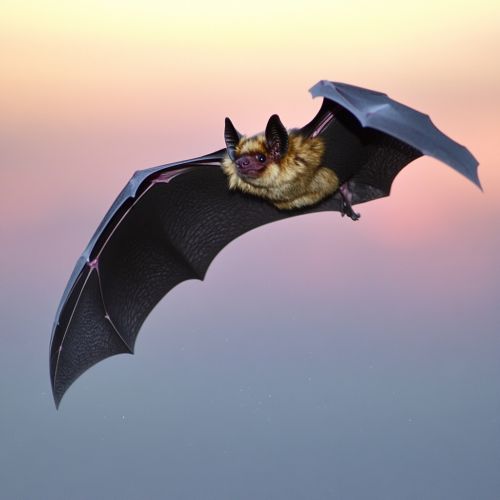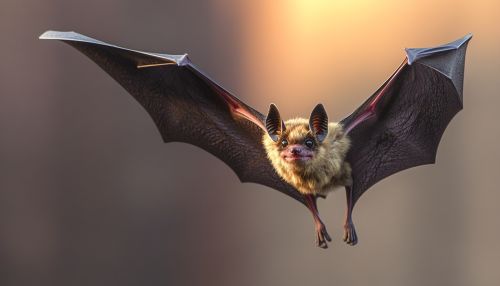Bats: Difference between revisions
(Created page with "== Introduction == Bats are mammals of the order Chiroptera, the second largest order of mammals after rodents. They are the only mammals capable of sustained flight, a trait that distinguishes them from other mammals such as flying squirrels and gliding possums. Bats play crucial roles in various ecosystems, including pollination, seed dispersal, and insect population control. == Taxonomy and Evolution == Bats are divided into two suborders: Megachiroptera (lar...") |
No edit summary |
||
| Line 8: | Line 8: | ||
Bats possess several unique anatomical features that enable flight and echolocation. Their wings are formed by a thin membrane of skin stretched between elongated finger bones. The wing structure allows for a high degree of maneuverability and agility in the air. Bats have a specialized [[pectoral girdle]] and robust chest muscles to support the demands of flight. | Bats possess several unique anatomical features that enable flight and echolocation. Their wings are formed by a thin membrane of skin stretched between elongated finger bones. The wing structure allows for a high degree of maneuverability and agility in the air. Bats have a specialized [[pectoral girdle]] and robust chest muscles to support the demands of flight. | ||
[[Image:Detail-98037.jpg|thumb|center|A bat in mid-flight against a twilight sky.|class=only_on_mobile]] | |||
[[Image:Detail-98038.jpg|thumb|center|A bat in mid-flight against a twilight sky.|class=only_on_desktop]] | |||
The [[cardiovascular system]] of bats is highly adapted to meet the metabolic demands of flight. They have a high heart rate and increased blood flow to the wings. Bats also exhibit a unique respiratory system, with a high lung surface area to facilitate efficient gas exchange. | The [[cardiovascular system]] of bats is highly adapted to meet the metabolic demands of flight. They have a high heart rate and increased blood flow to the wings. Bats also exhibit a unique respiratory system, with a high lung surface area to facilitate efficient gas exchange. | ||
Latest revision as of 14:03, 20 September 2024
Introduction
Bats are mammals of the order Chiroptera, the second largest order of mammals after rodents. They are the only mammals capable of sustained flight, a trait that distinguishes them from other mammals such as flying squirrels and gliding possums. Bats play crucial roles in various ecosystems, including pollination, seed dispersal, and insect population control.
Taxonomy and Evolution
Bats are divided into two suborders: Megachiroptera (large fruit bats, also known as flying foxes) and Microchiroptera (small insect-eating bats). The evolutionary history of bats is complex and not fully understood, but fossil evidence suggests that they have been around for at least 50 million years. The earliest known bat fossils, such as those of the genus Icaronycteris, exhibit characteristics of both suborders, indicating a common ancestor.
Anatomy and Physiology
Bats possess several unique anatomical features that enable flight and echolocation. Their wings are formed by a thin membrane of skin stretched between elongated finger bones. The wing structure allows for a high degree of maneuverability and agility in the air. Bats have a specialized pectoral girdle and robust chest muscles to support the demands of flight.


The cardiovascular system of bats is highly adapted to meet the metabolic demands of flight. They have a high heart rate and increased blood flow to the wings. Bats also exhibit a unique respiratory system, with a high lung surface area to facilitate efficient gas exchange.
Echolocation
Echolocation is a biological sonar used by most Microchiroptera and some Megachiroptera to navigate and hunt in the dark. Bats emit high-frequency sound waves that bounce off objects and return as echoes, which are processed by the bat's brain to create a detailed spatial map of their surroundings. The auditory cortex of bats is highly developed, allowing them to detect minute differences in echo timing and frequency.
Reproduction and Lifespan
Bats exhibit a variety of reproductive strategies, including delayed fertilization, delayed implantation, and delayed development. These adaptations allow bats to synchronize the birth of their young with periods of high food availability. Gestation periods vary among species but typically range from 40 days to six months. Bat pups are usually born in the spring or early summer and are cared for by their mothers until they are capable of flight.
Bats have relatively long lifespans for their size, with some species living over 30 years. Factors contributing to their longevity include low predation rates and efficient DNA repair mechanisms.
Diet and Feeding Behavior
The diet of bats is highly diverse and species-specific. Microchiroptera primarily consume insects, using echolocation to detect and capture prey. Some species specialize in eating specific types of insects, such as moths or beetles. Megachiroptera, on the other hand, are primarily frugivorous, feeding on fruits, nectar, and pollen. These bats play a vital role in pollination and seed dispersal, particularly in tropical ecosystems.
Habitat and Distribution
Bats are found on every continent except Antarctica and inhabit a wide range of environments, from tropical rainforests to deserts. They roost in various structures, including caves, trees, and man-made buildings. Roosting sites are critical for bats, providing shelter from predators and harsh weather conditions. Some species are highly migratory, traveling long distances between seasonal roosts.
Conservation Status
Many bat species are currently facing significant threats, including habitat loss, climate change, and disease. White-nose syndrome, a fungal disease, has decimated bat populations in North America. Conservation efforts are focused on habitat protection, disease management, and public education to mitigate these threats. Bats are also protected under various international agreements, such as the Convention on the Conservation of Migratory Species of Wild Animals.
Human Interaction
Bats have a complex relationship with humans. While they are beneficial for pest control and pollination, they are also associated with the transmission of zoonotic diseases, such as rabies and Ebola. Public perception of bats is often negative, fueled by myths and misconceptions. Efforts to promote bat conservation include public education campaigns and the establishment of bat-friendly habitats.
